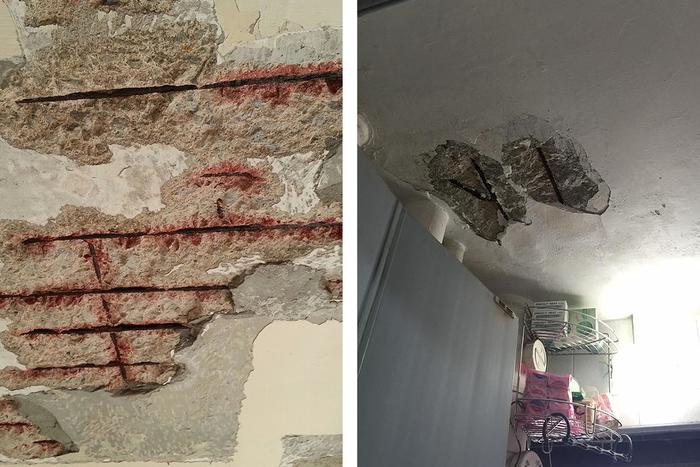Spalling concrete is a surface maintenance problem that causes ceilings in older buildings to crack and bulge.
Living in an older HDB estate has its perks: you get to be part of a charming neighbourhood surrounded by amenities, and you might even be lucky enough to own a ‘rare’ flat in mature, developed estates.

However, you might also have to deal with building issues that come with age; some problems that you might face include pipe leaks, old wiring, and potentially, spalling concrete.
So, what exactly is spalling concrete?
At first glance, concrete might seem like a firm, stone-like material that’s capable of taking anything thrown at it. But the fact is, concrete blocks have to be reinforced with steel rods and/or cables before they are capable of handling the stresses of modern engineering.

Source: The Straits Times
Unfortunately, this isn’t a perfect solution either as these steel reinforcements can corrode due to carbonation (a natural deterioration process that occurs due to the interaction of carbon dioxide and calcium hydroxide in the cement paste) which then causes spalling to occur. As these cracks spread, they may gradually affect the structural integrity of your home.
What warning signs should you look out for?
As with any issue caused by time, signs of wear and tear are the main indicators of spalling concrete. These include:
1. Rust stains
Rust appears when steel reinforcements within sections of reinforced concrete begin corroding. These reddish-brown stains can be easily noticed through a simple visual inspection and often look as though they are seeping out from the concrete.

2. Pits and flaking
Pits are small holes that can be seen on reinforced concrete surfaces and they are often indicative of internal corrosion. The same goes for flaking, which occurs when outer layers of concrete start popping out due to wear and tear on the inside.
3. Falling chunks
The most serious (and obvious) indicator of concrete spalling is when concrete from your ceiling starts falling off. Needless to say, this is a sign that you shouldn’t ignore!

How do you prevent concrete spalling?
While concrete spalling can lead to serious damage if it’s neglected for a long period, it’s actually a minor problem that can be taken care of with regular maintenance. The preventive steps that HDB recommends are as follows:
• Ensure any cracks/holes are sealed properly – Any cracks/holes that allow moisture or carbon dioxide to enter should be patched; the same goes for any drilled holes that are no longer in use.
• Have sufficient ventilation – Wet surroundings, such as the kitchen, bathroom, and toilet, can cause carbonation to speed up due to increased humidity, so be sure to air these spaces out.
• Repaint your ceiling! – Other than giving your home a new look, a fresh coat of paint also protects against concrete spalling as it prevents carbonation from occurring.
Get to know HDB and your home better!
This article was adapted in collaboration with MyNiceHome, HDB’s official website for all things related to home buying and renovation in Singapore.
Already collected the keys to your HDB flat? Get interior designer recommendations from us for free!

 Get a budget estimate before meeting IDs
Get a budget estimate before meeting IDs